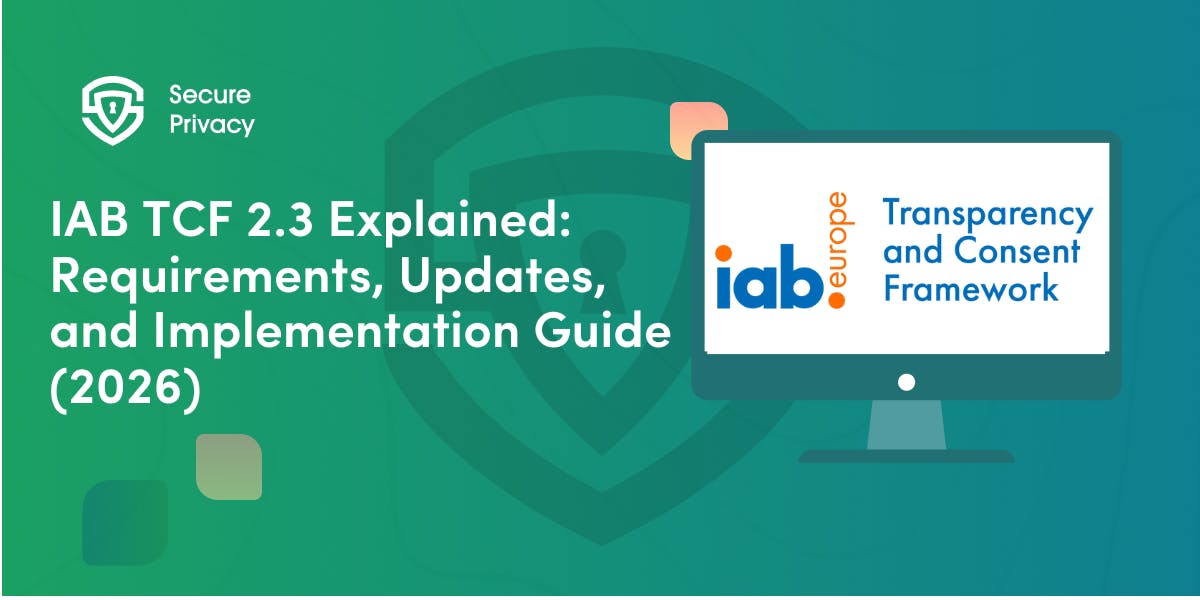Understanding the Difference: Clickwrap Agreement vs. Browsewrap Agreement, and Enforceability of Terms and Conditions
Discover the ins and outs of clickwrap and browsewrap agreements in our comprehensive blog post. Learn their impact on user experience, enforceability under data privacy regulations, and how to choose the right agreement for your website. Clickwrap vs. browsewrap compared, including advantages, disadvantages, and crucial legal considerations.
Imagine this: you've launched your dream website, but the thought of those pesky terms and conditions sends shivers down your spine. How do you ensure users agree to your terms while avoiding legal pitfalls? Enter the world of clickwrap and browsewrap agreements!
This blog post is your one-stop shop for understanding these online contracts, their impact on user experience, and most importantly, their enforceability in the eyes of the law. We'll delve into the specifics of each agreement, explore their enforceability under data privacy regulations like GDPR and CCPA, and equip you with the knowledge to choose the right agreement for your needs.
What's the difference between a clickwrap and a browsewrap agreement?
The main difference between a clickwrap and a browsewrap agreement lies in how users express their consent to the terms of service or terms and conditions (T&Cs).]
Clickwrap Agreement
A clickwrap agreement is a type of online agreement where users actively demonstrate their acceptance of terms and conditions by clicking a button or checking a box. This click serves as a digital "handshake" and creates a record of user consent. Imagine it as a polite doorman at a club asking you to acknowledge the rules before entering.
Here's how it works:
- Presentation: The T&Cs are prominently displayed before accessing a website, app, software, or digital service.
- Active Consent: Users are required to click a button or check a box explicitly stating their agreement with the T&Cs. This could be a "I Agree" button, a checkbox labeled "Accept Terms", or similar.
- Consent Record: The click or checkbox action is recorded, creating a digital trail of user acceptance.
Benefits of Clickwrap Agreements:
- Clear Evidence of Consent: The active click provides firm proof of user awareness and acceptance, making it easier to enforce the agreement in court.
- Transparency: Clickwrap agreements typically present the T&Cs in a clear and accessible format, reducing the risk of misunderstandings.
- User Control: Users have a clear choice to accept or reject the terms before proceeding.
Drawbacks of Clickwrap Agreements:
- Potential for User Fatigue: Users might click mindlessly without reading the T&Cs, leading to potential legal issues later.
- Accessibility Concerns: For users with disabilities or limited technical skills, navigating clickwrap agreements can be challenging.
- Over-reliance on Technology: Technical glitches or malfunctioning buttons could invalidate the user's consent.
Browserwrap Agreement
A browsewrap agreement is an online agreement where users are deemed to accept the terms and conditions of a website or digital service simply by using or accessing it. Unlike clickwrap agreements that require an active confirmation, browsewrap agreements rely on the assumption that users are aware of and agree to the terms by continuing to browse or use the platform.
Here's how browsewrap agreements typically function:
- Presence of T&Cs: The T&Cs are usually provided on the website or platform through a hyperlink or similar element. They are often accessible in the website footer or during the account creation process.
- Passive Consent: Users are not explicitly required to take any action to indicate their agreement with the T&Cs. Instead, their continued use of the website or service is considered acceptance.
- Enforceability Challenges: Browsewrap agreements can be more difficult to enforce compared to clickwrap agreements due to the potential difficulty in proving that users were aware of the terms and agreed to them.
Advantages of Browsewrap Agreements:
- Simplified User Experience: Browsewrap agreements do not interrupt the user's browsing or interaction with the website, allowing for a smoother user experience.
Disadvantages of Browsewrap Agreements:
- Enforceability Concerns: Since users are not required to actively indicate their consent, it can be challenging to demonstrate that they were aware of and agreed to the terms.
- Ambiguity and Misunderstandings: The placement and visibility of the T&Cs may vary, leading to potential misunderstandings or disputes regarding user consent.
- Limited User Choice: Users may feel that they have limited control over the agreement terms, as they are automatically bound by them without explicitly agreeing.
Which agreement is more enforceable?
Generally, clickwrap agreements are considered more enforceable than browsewrap agreements due to the stronger evidence of user consent they provide.
Unlike browsewrap's passive approach, clickwrap demands a deliberate action like a click or checkbox. This proves clear awareness and intention. Plus, clickwrap presents the terms prominently, giving users a fair chance to read and understand before agreeing. Browsewrap hides the terms in menus and legalese, making them elusive. Clickwrap also empowers users with a clear choice to accept or reject, while browsewrap's implied consent feels forced. Finally, clickwrap leaves a digital record of consent, while browsewrap lacks proof users even knew about the terms. However, remember that enforceability can vary based on specific circumstances and legal landscapes.
However, it's important to note that enforceability can also depend on specific circumstances, legal precedents, and the jurisdiction where the dispute arises. Some countries have stricter regulations regarding browsewrap agreements and may allow exceptions to their enforceability depending on the specific context.
When should I use a clickwrap agreement?
Deciding whether to use a clickwrap agreement depends on several factors related to your specific situation and the nature of your online service or product.
Clickwrap shines when stakes are high. Handling sensitive data? Clickwrap strengthens your legal position with solid consent proof. Ditto for complying with privacy rules like GDPR. Crucial terms about usage or disputes? Clickwrap makes sure users acknowledge them. Plus, it hands users the reins to accept or reject, boosting control. Long, complex terms? Clickwrap ensures users review them before diving in, minimizing future confusion.
But hold on – clickwrap has downsides too. Too many clickwrap pop-ups? User fatigue ensues. Think accessibility – users with disabilities might struggle. Even technical glitches can throw consent into question.
So, when choosing between clickwrap and other options, weigh your specific needs and the nature of your online offering. Clickwrap might be the hero for high-stakes situations, but consider its potential side effects before making the call.
Are there any exceptions to the enforceability of clickwrap agreements?
Clickwrap might be the legal heavyweight, but it's not invincible. Unfair terms, hidden agreements, or forced choices can all weaken its punch. Even technical glitches can throw its consent record into question.
Think of it like a locked castle – strong, but vulnerabilities exist. Unbalanced terms are like rickety gates, easily challenged. Hidden agreements are like secret tunnels, allowing users to bypass consent. Lack of choice is like a single entrance controlled by the service provider – not a fair fight. And technical glitches are like malfunctioning drawbridges, throwing consent into the moat.
Remember, enforceability depends on location and legal history. Different countries have their own rules, and past court cases can set precedents for future battles. So, while clickwrap offers sturdy defenses, crafting fair terms, presenting them clearly, and respecting user choice are key to keeping your legal castle standing strong.
When might a browsewrap agreement be acceptable?
The enforceability of browsewrap agreements is a complex and evolving legal issue. While they're commonly used by websites to present their terms and conditions, their validity is frequently challenged based on concerns about user awareness and consent. But like a scrappy underdog, it has its moments.
Crystal clear notice? Prominent links, simple language – that's browsewrap at its best. Low-risk interactions, like reading news articles? Perfect turf. Even industry norms can lend it a hand. And if users click "Next" after a sneaky hyperlink, well, maybe the court throws it a bone.
But remember, browsewrap is always on thin ice. The law changes, judges have their own opinions, and specific situations can tip the scales. So while it might squeak by sometimes, don't rely on it to hold up in a legal brawl.
Can't I just use both in one document?
Mixing clickwrap and browsewrap? Think twice. It's like playing chess with checkers – the rules clash, causing confusion and weakening your position. Why the mess? Clickwrap wants an active "I agree," while browsewrap assumes consent just by visiting. This ambiguity leaves judges scratching their heads – which rule wins?
Even worse, clickwrap, the stronger legal fighter, gets dragged down by browsewrap's flimsy defenses. Courts favor clear consent, and browsewrap's passive approach feels weak. Users get frustrated too, feeling trapped by hidden terms or unsure which rules apply. Trust suffers, and your website ends up in a stalemate.
Drafting this hybrid beast is no easy feat. It's like building a bridge with mismatched parts – wobbly and prone to collapse. Legal experts might be needed to patch the gaps and avoid legal quicksand.
So, skip the confusion and stick to one clear method. Clickwrap for high-stakes situations, browsewrap for light interactions. Choose your weapon wisely, and your website will reign supreme on the legal battlefield.
What else can I do to strengthen my T&Cs enforceability?
Beyond the fundamental strategies of clarity, consent, and addressing user concerns, a multitude of tactics can bolster the enforceability of your T&Cs. Let's delve deeper into some specific actions:
- Tailor your terms to your specific context: Generic T&Cs are recipe for trouble. Adapt your language and conditions to the unique nature of your platform, target audience, and industry. For example, an e-commerce site might emphasize return policies and dispute resolution, while a social media platform would focus on content moderation and user conduct.
- Employ layering and segmentation: Don't overwhelm users with a dense wall of text. Utilize layered T&Cs, presenting essential terms upfront with clear links to more detailed sections for those who wish to delve deeper. This avoids information overload while ensuring users have access to comprehensive information.
- Leverage technology to your advantage: Interactive elements like tooltips, hover text, and FAQs can enhance user understanding within the T&Cs themselves. Consider incorporating short, digestible video explanations for key clauses, making them readily accessible and engaging.
- Stay informed and adapt: The legal landscape surrounding T&Cs is constantly evolving. Stay apprised of changes in relevant laws and regulations, promptly updating your T&Cs to reflect the latest requirements. Proactive adaptation demonstrates a commitment to user protection and strengthens enforceability.
- Consider international implications: If your platform operates across borders, ensure your T&Cs comply with the legal frameworks of all relevant jurisdictions. This might necessitate multiple versions of T&Cs tailored to specific regions, requiring careful attention to detail and legal expertise.
- Embrace transparency and accountability: Don't shy away from addressing potentially sensitive topics within your T&Cs. Be upfront about data collection practices, user privacy rights, and potential limitations of your platform. Transparency fosters trust and demonstrates a commitment to ethical conduct.
- Foster open communication: Encourage users to engage with your T&Cs. Provide clear channels for them to ask questions, raise concerns, or seek clarifications. This not only builds trust but also helps identify potential ambiguities or areas for improvement in your terms.
- Prioritize user-friendliness: Remember, your T&Cs are not meant to be impenetrable legal documents. Strive for clear, concise language, avoiding overly technical jargon or legalese. Use formatting techniques like bullet points and headings to improve readability and navigation.
- Embrace ongoing evaluation: Don't treat your T&Cs as a static document. Regularly review and assess their effectiveness in light of user feedback, legal changes, and evolving industry standards. Proactive evaluation and updates ensure your T&Cs remain relevant, enforceable, and user-friendly.
By implementing these strategies, you can move beyond the basics of clarity and consent to build a robust T&Cs framework that safeguards your business while fostering trust and transparency with your users. Remember, strong T&Cs are not just about legal compliance; they are a cornerstone of building a sustainable and ethical online presence.
What about international differences in T&Cs enforceability?
International differences in T&Cs enforceability pose a significant challenge for businesses operating across borders. Here's a closer look at some key considerations:
- Jurisdiction matters: Your T&Cs are subject to the laws of the jurisdiction where your business is located and the jurisdictions where your users reside. This means different clauses might be enforceable in some countries but not in others, creating a complex patchwork of legal implications.
- Choice of law clauses: While not universally effective, incorporating a "choice of law" clause can specify which jurisdiction's laws will govern the interpretation and enforcement of your T&Cs. However, the chosen jurisdiction must have a sufficient connection to the agreement for the clause to be upheld.
- Consumer protection laws: Varying consumer protection laws across countries can significantly impact the enforceability of certain T&Cs clauses. For example, clauses deemed "unfair" or "abusive" under one country's laws might be perfectly valid in another.
- Language barriers: Translating your T&Cs into multiple languages is crucial, but ensuring accuracy and clarity across languages can be challenging. Nuances in legal terminology and cultural differences can lead to unintended interpretations, impacting enforceability.
- Data privacy regulations: Compliance with international data privacy regulations like GDPR and CCPA adds another layer of complexity. Your T&Cs must clearly explain your data collection practices, user rights, and how you comply with relevant regulations in different jurisdictions.
Navigating these challenges requires a multi-pronged approach. :
- Seek legal counsel: Consulting with lawyers specializing in international T&Cs is crucial. They can advise on legal compliance in relevant jurisdictions and draft clauses that are enforceable across borders.
- Adapt your T&Cs: Develop separate versions of your T&Cs tailored to the specific legal and regulatory requirements of each region you operate in.
- Prioritize transparency: Be clear and upfront about how you handle user data, resolve disputes, and comply with local laws in each jurisdiction.
- Embrace localization: Don't just translate your T&Cs; adapt them to the cultural and legal context of each region. Consider using local examples and language that resonates with your users.
- Stay informed: Keep up with evolving legal landscapes and data privacy regulations in different countries. Regularly review and update your T&Cs to ensure compliance and effectiveness.
By carefully considering these factors and taking proactive steps, you can strengthen the enforceability of your T&Cs in a globalized world, protecting your business while fostering trust and transparency with your users across borders.
What are the alternatives to using clickwrap or browsewrap agreements?
While clickwrap and browsewrap are common methods for obtaining user consent, they're not the only options. Here are some alternatives for small businesses:
- Signed contracts: For high-value transactions or complex services, consider traditional signed contracts. This provides a tangible record of agreement and is generally considered the most enforceable option.
- Explicit opt-in boxes: Instead of relying on pre-checked boxes, use clear opt-in boxes where users actively choose to agree to your terms. This emphasizes user control and can be more transparent.
- Layered disclosures: Break down your terms into digestible sections, presenting key terms upfront with links to detailed information for those who want it. This avoids overwhelming users while ensuring they have access to all the information.
- In-app prompts: For mobile apps, use contextual prompts at key points where users need to make specific choices. This keeps the terms relevant and avoids bombarding users with upfront legalese.
Regardless of the method you choose, prioritize clear, concise language in your terms. Avoid legal jargon and technical terms, and focus on explaining things in a way that your users can understand. Remember, the best approach depends on your specific needs and the nature of your business.
What if I have a website with both clickwrap and browsewrap elements?
Combining clickwrap and browsewrap on the same website isn't ideal. It raises confusion about which agreement controls and weakens the enforceability of both:
- Clickwrap: Strong evidence of user consent, but browsewrap elements might make it seem ambiguous.
- Browsewrap: Weak on its own, relying on user actions like scrolling as implied consent. Clickwrap complicates things further.
Consider these alternatives:
- Focus on clickwrap: Make it prominent and ensure users understand clicking "Agree" binds them.
- Layered approach: Present key terms with clickwrap, then link to detailed browsewrap info for deeper dives.
- Separate agreements: Use clickwrap for crucial terms and browsewrap for less critical information.
Remember, clarity and user understanding are key. Avoid confusing double-barrel approaches and prioritize transparency in your agreements.
I'm a small business owner. Do I need T&Cs at all?
Whether or not you need Terms & Conditions as a small business owner depends on several factors, but they're generally recommended for most businesses, even small ones.
T&Cs establish the rules and expectations for the use of your products or services, helping prevent disputes, clarifying responsibilities, and outlining key legal aspects. They provide transparency, protect your business interests, and contribute to building trust with customers. Even for small operations, clear T&Cs are a valuable tool for setting the terms of engagement and mitigating potential legal risks.
Get Started For Free with the
#1 Cookie Consent Platform.
No credit card required

What is Cookie Consent? A Quick 2026-Ready Glance
Your website loads. Cookies track users. But without proper cookie consent, you're violating GDPR — risking fines up to €20 million or 4% of global revenue. Cookie consent is the legally required mechanism by which websites obtain explicit user approval before deploying non-essential tracking technologies. This requirement stems from GDPR Article 4(11) and the ePrivacy Directive, mandating that consent must be freely given, specific, informed, and unambiguous.
- Legal & News

DSAR Tools Explained: Best Software for Automating Privacy Requests
You're drowning in data subject access requests. Manual searches through dozens of systems miss regulatory deadlines and expose organizations to fines starting at $2,500 per violation. The solution? DSAR tools — purpose-built software that automates the entire process of responding to data subject access requests, from intake to delivery.
- Legal & News

IAB TCF 2.3 Explained: Requirements, Updates, and Implementation Guide (2026)
Your ad revenue dropped 40% overnight. Google stopped bidding on your inventory. Your DSP partners flagged your traffic as non-compliant. The culprit? An outdated TCF 2.2 consent string after the February 2026 enforcement deadline.
- Legal & News
- Cookie Consent

